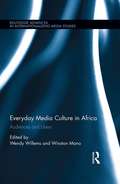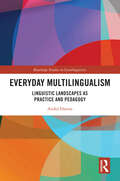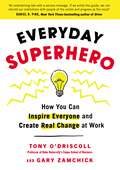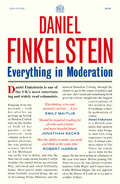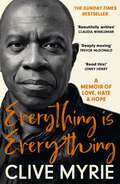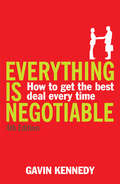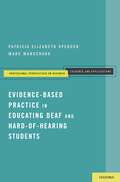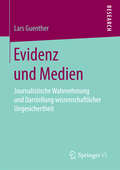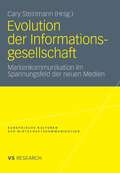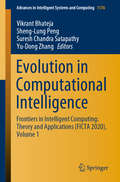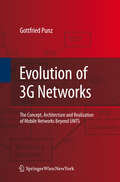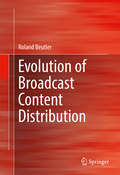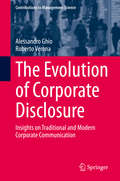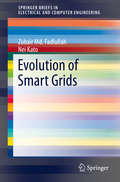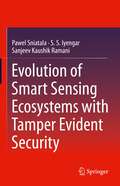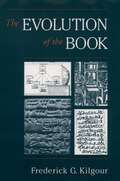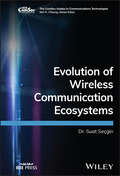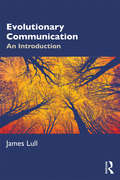- Table View
- List View
Everyday Media Culture in Africa: Audiences and Users (Routledge Advances in Internationalizing Media Studies)
African audiences and users are rapidly gaining in importance and increasingly targeted by global media companies, social media platforms and mobile phone operators. This is the first edited volume that addresses the everyday lived experiences of Africans in their interaction with different kinds of media: old and new, state and private, elite and popular, global and national, material and virtual. So far, the bulk of academic research on media and communication in Africa has studied media through the lens of media-state relations, thereby adopting liberal democracy as the normative ideal and examining the potential contribution of African media to development and democratization. Focusing instead on everyday media culture in a range of African countries, this volume contributes to the broader project of provincializing and decolonizing audience and internet studies.
Everyday Multilingualism: Linguistic Landscapes as Practice and Pedagogy (Routledge Studies in Sociolinguistics)
by Anikó HatossHatoss explores multilingualism in diverse suburbs of Sydney through the oral and written narratives of student ethnographers. Her research is based on visual ethnography, interviews with local residents and classroom discussions of the fieldwork. The findings of this book contribute to the scholarship of sociolinguistics of globalisation and seek to enhance our understanding of the complex interrelationship between the linguistic landscape and its participants: how language choices are negotiated, how identity and ideologies shape interactions in everyday contexts of the urban landscape. The narrative approach provides a multi-layered analysis to better understand the micro and macro connections shaping everyday interactions, conviviality and social relations. Hatoss offers methodological and pedagogical insights into the development of global citizenship and intercultural competence through the experiential learning provided by the linguistic landscape project. This volume is a useful source for researchers working in diverse fields of multilingualism, diaspora studies, narratives and digital ethnographies in sociolinguistics. It offers methodological insights to the study of urban multilingualism and pedagogical insights into using linguistic landscapes for developing intercultural competence.
Everyday Multilingualism: Linguistic Landscapes as Practice and Pedagogy (Routledge Studies in Sociolinguistics)
by Anikó HatossHatoss explores multilingualism in diverse suburbs of Sydney through the oral and written narratives of student ethnographers. Her research is based on visual ethnography, interviews with local residents and classroom discussions of the fieldwork. The findings of this book contribute to the scholarship of sociolinguistics of globalisation and seek to enhance our understanding of the complex interrelationship between the linguistic landscape and its participants: how language choices are negotiated, how identity and ideologies shape interactions in everyday contexts of the urban landscape. The narrative approach provides a multi-layered analysis to better understand the micro and macro connections shaping everyday interactions, conviviality and social relations. Hatoss offers methodological and pedagogical insights into the development of global citizenship and intercultural competence through the experiential learning provided by the linguistic landscape project. This volume is a useful source for researchers working in diverse fields of multilingualism, diaspora studies, narratives and digital ethnographies in sociolinguistics. It offers methodological insights to the study of urban multilingualism and pedagogical insights into using linguistic landscapes for developing intercultural competence.
Everyday Superhero: How You Can Inspire Everyone And Create Real Change At Work
by Tony O'Driscoll Gary Zamchick'An entertaining tale with a serious message . . . we can rebuild our institutions with people at the centre and progress as the result!' Daniel H. Pink, bestselling author of DriveAre you struggling to create profound, lasting change in your organisation? Everyday Superhero is a simple story with a powerful solution. Meet a stressed young manager, Mae B, whose teams are being led by an authoritarian CEO. We join her on her mission to overhaul the outdated leadership systems obsessed by power, profit and process and fight for central leadership that prioritises people, purpose and principles. It's the start of a journey into a new vision of leadership, one that has been designed to take on the challenges that organisations face today. And if we follow Mae B's lead, we can all create change, when we need it most. Developed from the author's academic research at Duke University, this memorable adventure will help you create lasting change in complex and chaotic times.'This powerful book tells the story of how leaders can unlock every employee's superpower to create lasting change' Dorie Clark, bestselling author of The Long Game
Everything in Moderation
by Daniel Finkelstein‘How long does a column take? Well it’s 1,150 words and it takes usually between two and three hours to write down. But in reality it has taken me somewhere between three hours and the entirety of my life since I was eight years old.’
Everything is Everything: The Top 10 Bestseller
by Clive Myrie'Infinitely more readable than the average journalism memoir, and decidedly more important.' - Sathnam Sanghera, The Times'So engaging. You feel as if he is talking to you, sharing ideas and thoughts, as if you were a friend.' - Yasmin Ahlibai-BrownAs a Bolton teenager with a paper round, Clive Myrie read all the newspapers he delivered from cover to cover and dreamed of becoming a journalist. In this deeply personal memoir, he tells how his family history has influenced his view of the world, introducing us to his Windrush generation parents, a great grandfather who helped build the Panama Canal, and a great uncle who fought in the First World War, later to become a prominent police detective in Jamaica.He reflects on how being black has affected his perspective on issues he's encountered in thirty years reporting some of the biggest stories of our time (most recently from Ukraine), showing us how those experiences gave him a better idea of what it means to be an outsider. He tells of his pride in his roots, but his determination not to be defined by his background in dealing with the challenges of race and class to succeed at the highest level. Moving, engaging, revealing, Everything is Everything is a story of love and hate - but also hope.
Everything is Negotiable: 4th Edition
by Gavin KennedyWhether you need to ask for a raise at work, request a better hotel room while you're on holiday, or even debate with your stubborn teenager at home, you can learn effective and powerful negotiation skills to help you get the best deal every time.In this fully revised and updated fourth edition of the worldwide success Everything is Negotiable, expert negotiator Gavin Kennedy walks you through all the techniques and tricks you need to get the best deal in any situation. With chapters on such subjects as making your offer count, dealing with intimidation and getting it in writing, as well as self-assessment tests to help chart your progress, Everything is Negotiable is a one-stop shop for anyone who wants to improve their negotiation skills. Superbly practical and insightful, this essential guide will make sure you come out top in any negotiation.
Evidence-Based Practice in Educating Deaf and Hard-of-Hearing Students (Professional Perspectives on Deafness: Evidence and Applications)
by Marc Marschark Patricia Elizabeth SpencerDebates about methods of supporting language development and academic skills of deaf or hard-of-hearing children have waxed and waned for more than 100 years: Will using sign language interfere with learning to use spoken language or does it offer optimal access to communication for deaf children? Does placement in classrooms with mostly hearing children enhance or impede academic and social-emotional development? Will cochlear implants or other assistive listening devices provide deaf children with sufficient input for age-appropriate reading abilities? Are traditional methods of classroom teaching effective for deaf and hard-of-hearing students? Although there is a wealth of evidence with regard to each of these issues, too often, decisions on how to best support deaf and hard-of-hearing children in developing language and academic skills are made based on incorrect or incomplete information. No matter how well-intentioned, decisions grounded in opinions, beliefs, or value judgments are insufficient to guide practice. Instead, we need to take advantage of relevant, emerging research concerning best practices and outcomes in educating deaf and hard-of-hearing learners. In this critical evaluation of what we know and what we do not know about educating deaf and hard-of-hearing students, the authors examine a wide range of educational settings and research methods that have guided deaf education in recent years--or should. The book provides a focus for future educational and research efforts, and aims to promote optimal support for deaf and hard-of-hearing learners of all ages. Co-authored by two of the most respected leaders in the field, this book summarizes and evaluates research findings across multiple disciplines pertaining to the raising and educating of deaf children, providing a comprehensive but concise record of the successes, failures, and unanswered questions in deaf education. A readily accessible and invaluable source for teachers, university students, and other professionals, Evidence-Based Practice in Educating Deaf and Hard-of-Hearing Students encourages readers to reconsider assumptions and delve more deeply into what we really know about deaf and hard-of-hearing children, their patterns of development, and their lifelong learning.
Evidence-Based Practice in Educating Deaf and Hard-of-Hearing Students (Professional Perspectives on Deafness: Evidence and Applications)
by Patricia Elizabeth Spencer Marc MarscharkDebates about methods of supporting language development and academic skills of deaf or hard-of-hearing children have waxed and waned for more than 100 years: Will using sign language interfere with learning to use spoken language or does it offer optimal access to communication for deaf children? Does placement in classrooms with mostly hearing children enhance or impede academic and social-emotional development? Will cochlear implants or other assistive listening devices provide deaf children with sufficient input for age-appropriate reading abilities? Are traditional methods of classroom teaching effective for deaf and hard-of-hearing students? Although there is a wealth of evidence with regard to each of these issues, too often, decisions on how to best support deaf and hard-of-hearing children in developing language and academic skills are made based on incorrect or incomplete information. No matter how well-intentioned, decisions grounded in opinions, beliefs, or value judgments are insufficient to guide practice. Instead, we need to take advantage of relevant, emerging research concerning best practices and outcomes in educating deaf and hard-of-hearing learners. In this critical evaluation of what we know and what we do not know about educating deaf and hard-of-hearing students, the authors examine a wide range of educational settings and research methods that have guided deaf education in recent years--or should. The book provides a focus for future educational and research efforts, and aims to promote optimal support for deaf and hard-of-hearing learners of all ages. Co-authored by two of the most respected leaders in the field, this book summarizes and evaluates research findings across multiple disciplines pertaining to the raising and educating of deaf children, providing a comprehensive but concise record of the successes, failures, and unanswered questions in deaf education. A readily accessible and invaluable source for teachers, university students, and other professionals, Evidence-Based Practice in Educating Deaf and Hard-of-Hearing Students encourages readers to reconsider assumptions and delve more deeply into what we really know about deaf and hard-of-hearing children, their patterns of development, and their lifelong learning.
Evidence-Based Treatment of Stuttering: Empirical Bases and Clinical Applications
by Anne K. BotheThis book is the result of a "State-of-the-Art-Conference" held at the University of Georgia dedicated to the evidence-based treatment of stuttering. An international group of prominent fluency researchers and clinicians were invited to present and discuss current data and issues related to the treatment of stuttering. The topic was defined to include evidence about stuttering, evidence about stuttering treatment, and discussions of how that evidence should guide the continuing research and practice. The explicit link between empirical evidence and suggestions for clinical practice is the goal of the book. The book begins by addressing the notion of "evidence-based practice" and considers its implications for stuttering treatment. Part II presents the intersection of the nature of stuttering; the theories of stuttering; and the implications of nature, theory, and other knowledge for stuttering treatment decisions. Part III provides two of the many measurement issues facing stuttering treatment followed by Part IV, which is devoted to the quality of treatment research evidence, for specific treatments and in terms of some more general methodological and professional issues. The final part summarizes the clinical recommendations made throughout the book and discusses evidence-based, outcomes-focused clinical decisions for stuttering. These chapters are intended to provide "state-of-the-art" information to researchers, clinicians, and students who are interested in developing, identifying, or using the best possible evidence-based treatments for stuttering.
Evidence-Based Treatment of Stuttering: Empirical Bases and Clinical Applications
by Anne K. BotheThis book is the result of a "State-of-the-Art-Conference" held at the University of Georgia dedicated to the evidence-based treatment of stuttering. An international group of prominent fluency researchers and clinicians were invited to present and discuss current data and issues related to the treatment of stuttering. The topic was defined to include evidence about stuttering, evidence about stuttering treatment, and discussions of how that evidence should guide the continuing research and practice. The explicit link between empirical evidence and suggestions for clinical practice is the goal of the book. The book begins by addressing the notion of "evidence-based practice" and considers its implications for stuttering treatment. Part II presents the intersection of the nature of stuttering; the theories of stuttering; and the implications of nature, theory, and other knowledge for stuttering treatment decisions. Part III provides two of the many measurement issues facing stuttering treatment followed by Part IV, which is devoted to the quality of treatment research evidence, for specific treatments and in terms of some more general methodological and professional issues. The final part summarizes the clinical recommendations made throughout the book and discusses evidence-based, outcomes-focused clinical decisions for stuttering. These chapters are intended to provide "state-of-the-art" information to researchers, clinicians, and students who are interested in developing, identifying, or using the best possible evidence-based treatments for stuttering.
Evidenz und Medien: Journalistische Wahrnehmung und Darstellung wissenschaftlicher Ungesichertheit
by Lars GuentherLars Guenther analysiert die Gründe für die jeweilige Berichterstattung über wissenschaftliche Evidenz von Wissenschaftsjournalisten vor dem Hintergrund des Spannungsverhältnisses Wissenschaft – Journalismus – Öffentlichkeit. Die Ergebnisse der eigenen Studien, die Erkenntnisse aus Inhaltsanalysen und Befragungen zusammenfassen, verweisen auf die dominante Rolle des Publikums: So machen Journalisten ihre Entscheidung, wie wissenschaftliche Evidenz dargestellt wird, vorrangig davon abhängig, wie stark sie glauben, dass ihre Leser und Zuhörer erwarten, dass Forschungsergebnisse eher gesichert oder ungesichert präsentiert werden sollen.
Evolution der Informationsgesellschaft: Markenkommunikation im Spannungsfeld der neuen Medien (Europäische Kulturen in der Wirtschaftskommunikation)
by Cary SteinmannEvolution in Computational Intelligence: Frontiers in Intelligent Computing: Theory and Applications (FICTA 2020), Volume 1 (Advances in Intelligent Systems and Computing #1176)
by Vikrant Bhateja Sheng-Lung Peng Suresh Chandra Satapathy Yu-Dong ZhangThis book presents the proceedings of 8th International Conference on Frontiers of Intelligent Computing: Theory and Applications (FICTA 2020), which aims to bring together researchers, scientists, engineers and practitioners to share new ideas and experiences in the domain of intelligent computing theories with prospective applications to various engineering disciplines. The book is divided into two volumes: Evolution in Computational Intelligence (Volume 1) and Intelligent Data Engineering and Analytics (Volume 2).Covering a broad range of topics in computational intelligence, the book features papers on theoretical as well as practical aspects of areas such as ANN and genetic algorithms, computer interaction, intelligent control optimization, evolutionary computing, intelligent e-learning systems, machine learning, mobile computing, and multi-agent systems. As such, it is a valuable reference resource for postgraduate students in various engineering disciplines.
Evolution of 3G Networks: The Concept, Architecture and Realization of Mobile Networks Beyond UMTS
by Gottfried PunzIn this chapter we describe the motivation for writing this book and explain its scope. Some remarks on nomenclature are given in order to help the reader with a fast and easy start. The concept and structure of the material compiled is p- sented, followed by some hints on how to make best use of it. Finally the status of standardization, on which this book is based, is described. 1. 1 Motivation Probably the main motivation for starting to draft the script for this book, and eventually to finish it, was the desire to have a more or less complete, up-to-date overview of mobile network technology for myself, not only when starting my work in 3GPP standardization, but also continuously afterwards. I realized that some of my colleagues were in search of the same, and I extrapolated to the point where, after 3G technology is in in the field for some time, the huge, new step of development would be implemented and finally exist in reality: a manifold of s- tem designers, SW engineers, solution consultants, test personnel, field tech- cians and service staff would have to deal with the underlying architecture, c- cepts and detailed procedures. Yet, I noticed in my roughly two decades of work as a engineer (in a few diverse fields) that compact, consistent, and balanced ov- view material, suitable for the wider audience is scarce.
Evolution of Broadcast Content Distribution
by Roland BeutlerThis book discusses opportunities for broadcasters that arise with the advent of broadband networks, both fixed and mobile. It discusses how the traditional way of distributing audio-visual content over broadcasting networks has been complemented by the usage of broadband networks. The author shows how this also gives the possibility to offer new types of interactive or so-called nonlinear services. The book illustrates how change in distribution technology is accelerating the need for broadcasters around the world to adapt their content distribution strategy and how it will impact the portfolios of content they offer.
The Evolution of Corporate Disclosure: Insights on Traditional and Modern Corporate Communication (Contributions to Management Science)
by Alessandro Ghio Roberto VeronaThis book provides a critical analysis of the evolution of corporate disclosure. Building upon prior academic literature, it assesses the most important changes in mandatory corporate disclosure, the growing relevance of social and environmental disclosure, and revolutionary new forms of corporate communication, in particular social media. It also includes empirical analyses that shed further light on the impact of voluntary communication, i.e. social and environmental reporting and corporate social media communication, on managerial and investment decisions. Lastly, it discusses new directions for accounting and corporate governance research on the theoretical and empirical challenges of corporate disclosure. Offering a wealth of relevant and timely advice, the book will help regulators design policies that allow businesses to overcome current and emerging economic, social, and technological challenges.
Evolution of Smart Grids (SpringerBriefs in Electrical and Computer Engineering #0)
by Zubair Md. Fadlullah Nei KatoThis SpringerBrief explores the opportunities and challenges posed by the smart grid. The evolution of the smart grid should allow consumers to directly communicate with their utility provider. However, complex issues such as architecture with legacy support, varying demand response and load management, varying price of power, and so forth can lead to various decision making challenges. It is essential to identify the scope and challenges of the smart grid in a comprehensive manner so as to ensure efficient delivery of sustainable, economic, and secure electricity supplies. This book provides an overview of the smart grid and its key advances in architecture, distribution management, demand-side response and load balancing, smart automation, electric storage, power loss minimization and security. Readers interested in a basic knowledge of electric grid and communication networks will find Evolution of Smart Grids useful. Readers who want more insight on smart grid research will also find this book a valuable resource.
Evolution of Smart Sensing Ecosystems with Tamper Evident Security
by Pawel Sniatala S.S. Iyengar Sanjeev Kaushik RamaniThis book presents an overview on security and privacy issues in dynamic sensor networks and Internet of Things (IoT) networks and provides a novel tamper evident technique to counter and defend against these security related issues. The mission of this book is to explain the evolution of techniques and strategies in securing information transfer and storage thus facilitating a digital transition towards the modern tamper evident systems. The goal is also to aid business organizations that are dependent on the analysis of the large volumes of generated data in securing and addressing the associated growing threat of attackers relentlessly waging attacks and the challenges in protecting the confidentiality, integrity and provenance of data. The book also provides a comprehensive insight into the secure communication techniques and tools that have evolved and the impact they have had in supporting and flourishing the business through the cyber era. This book also includes chapters that discuss the most primitive encryption schemes to the most recent use of homomorphism in ensuring the privacy of the data thus leveraging greater use of new technologies like cloud computing and others.
The Evolution of Team-Based Buddhist Scripture Translation in Tang China: United in Dharma (SpringerBriefs in Religious Studies)
by Sai Yau SiuOpen Access This open-access book provides a concise analysis of the apex of team-based translation of Buddhist scriptures during the Tang Dynasty, initiated by the notable gathering of translation experts led by Prabhākaramitra. Showcasing the diverse and innovative strategies of translators who joined forces to surmount barriers, this work highlights how their collaborative translation efforts facilitated the spread of Buddhist teachings throughout China. This book brings to light the often overlooked yet crucial roles of these translation teams and examines their organizational structures, translation processes, and the distinct roles of individual members, offering critical insights into the cultural and religious fabric of the period. By enhancing our understanding of the complex dynamics within these institutions, this work also addresses a significant gap in the historical study of sūtra translation in medieval China. It is an essential resource for scholars, students, and enthusiasts of Buddhism, translation studies, and Chinese history.
The Evolution of the Book
by Frederick G. KilgourDistinguished scholar and library systems innovator Frederick Kilgour tells a five-thousand-year story in this exciting work, a tale beginning with the invention of writing and concluding with the emerging electronic book. Calling on a lifetime of interest in the growth of information technology, Kilgour brings a fresh approach to the history of the book, emphasizing in rich, authoritative detail the successive technological advances that allowed the book to keep pace with ever-increasing needs for information. Borrowing a concept from evolutionary theory--the notion of punctuated equilibria--to structure his account, Kilgour investigates the book's three discrete historical forms--the clay tablet, papyrus roll, and codex--before turning to a fourth, still evolving form, the cyber book, a version promising swift electronic delivery of information in text, sound, and motion to anyone at any time. The clay tablet, initially employed as a content descriptor for sacks of grain, proved inadequate to the growing need for commercial and administrative records. Its successor the papyrus roll was itself succeeded by the codex, a format whose superior utility and information capacity led to sweeping changes in the management of accumulated knowledge, the pursuit of learning, and the promulgation of religion. Kilgour throughout considers closely both technological change and the role this change played in cultural transformation. His fascinating account of the modern book, from Gutenberg's invention of cast-type printing five hundred years ago to the arrival of books displayed on a computer screen, spotlights the inventors, engineers, and entrepreneurs who in creating the machinery of production and dissemination enabled the book to maintain its unique cultural power over time. Deft, provocative, and accessibly written, The Evolution of the Book will captivate book lovers as well as those interested in bibliographic history, the history of writing, and the history of technology.
The Evolution of the Book
by Frederick G. KilgourDistinguished scholar and library systems innovator Frederick Kilgour tells a five-thousand-year story in this exciting work, a tale beginning with the invention of writing and concluding with the emerging electronic book. Calling on a lifetime of interest in the growth of information technology, Kilgour brings a fresh approach to the history of the book, emphasizing in rich, authoritative detail the successive technological advances that allowed the book to keep pace with ever-increasing needs for information. Borrowing a concept from evolutionary theory--the notion of punctuated equilibria--to structure his account, Kilgour investigates the book's three discrete historical forms--the clay tablet, papyrus roll, and codex--before turning to a fourth, still evolving form, the cyber book, a version promising swift electronic delivery of information in text, sound, and motion to anyone at any time. The clay tablet, initially employed as a content descriptor for sacks of grain, proved inadequate to the growing need for commercial and administrative records. Its successor the papyrus roll was itself succeeded by the codex, a format whose superior utility and information capacity led to sweeping changes in the management of accumulated knowledge, the pursuit of learning, and the promulgation of religion. Kilgour throughout considers closely both technological change and the role this change played in cultural transformation. His fascinating account of the modern book, from Gutenberg's invention of cast-type printing five hundred years ago to the arrival of books displayed on a computer screen, spotlights the inventors, engineers, and entrepreneurs who in creating the machinery of production and dissemination enabled the book to maintain its unique cultural power over time. Deft, provocative, and accessibly written, The Evolution of the Book will captivate book lovers as well as those interested in bibliographic history, the history of writing, and the history of technology.
Evolution of Wireless Communication Ecosystems (The ComSoc Guides to Communications Technologies)
by Suat SecginEvolution of Wireless Communication Ecosystems Understand a world transformed by wireless communication with this groundbreaking guide Since the advent of the internet, few technologies have proven more transformative than wireless communication. Never have we lived in a more comprehensively connected world, with the cloud and the coming sixth generation (6G) of wireless technology creating a vast and interconnected communications infrastructure. Global citizens of this newly interconnected reality are grappling like never before with its many challenges. Evolution of Wireless Communication Ecosystems provides readers with a history of wireless communication and a thorough overview of emerging frontiers. It traces wireless communication from the first generation through to the current fifth before surveying the current state of wireless technology and the ongoing research into 6G. The result is a book that understands wireless communication for the first time as an ecosystem, endlessly interconnected, growing, and boundlessly complex, but made intelligible by this highly readable introduction. Readers will also find: Detailed explanations of the journey starting from 1G to 6G Descriptions the infrastructure of 4G, 5G, and 6G systems, this all-connected communication ecosystem, the sub-components of this ecosystem, and the relationship among them Depictions of events seen in the capillaries of the communication echo system that show switching techniques, modulation, and multiplexing techniques Coverage of access techniques, protocols, the methods used in M2M and IoT connections at the endpoints, and security issues that show how they are an integral part of wireless communication infrastructure Evolution of Wireless Communication Ecosystems from 1G to 6G is an essential reference for wireless and telecommunications professionals, as well as researchers interested in 6G or other emerging wireless technologies.
Evolution of Wireless Communication Ecosystems (The ComSoc Guides to Communications Technologies)
by Suat SecginEvolution of Wireless Communication Ecosystems Understand a world transformed by wireless communication with this groundbreaking guide Since the advent of the internet, few technologies have proven more transformative than wireless communication. Never have we lived in a more comprehensively connected world, with the cloud and the coming sixth generation (6G) of wireless technology creating a vast and interconnected communications infrastructure. Global citizens of this newly interconnected reality are grappling like never before with its many challenges. Evolution of Wireless Communication Ecosystems provides readers with a history of wireless communication and a thorough overview of emerging frontiers. It traces wireless communication from the first generation through to the current fifth before surveying the current state of wireless technology and the ongoing research into 6G. The result is a book that understands wireless communication for the first time as an ecosystem, endlessly interconnected, growing, and boundlessly complex, but made intelligible by this highly readable introduction. Readers will also find: Detailed explanations of the journey starting from 1G to 6G Descriptions the infrastructure of 4G, 5G, and 6G systems, this all-connected communication ecosystem, the sub-components of this ecosystem, and the relationship among them Depictions of events seen in the capillaries of the communication echo system that show switching techniques, modulation, and multiplexing techniques Coverage of access techniques, protocols, the methods used in M2M and IoT connections at the endpoints, and security issues that show how they are an integral part of wireless communication infrastructure Evolution of Wireless Communication Ecosystems from 1G to 6G is an essential reference for wireless and telecommunications professionals, as well as researchers interested in 6G or other emerging wireless technologies.
Evolutionary Communication: An Introduction
by James LullEvolutionary Communication presents the first comprehensive evolutionary approach to the study of human communication. Presuming no specialized knowledge of evolutionary theory, this reader-friendly textbook explains why and how communication became the determining factor in human development. Drawing from the latest scientific research, Evolutionary Communication represents a truly groundbreaking contribution to Communication Studies as a field of study. Opening up an inspiring new approach for teaching communication, the book can be used as a core volume or supplemental text for courses ranging from Introduction to Communication and Communication Theory to special topics and graduate seminars.
